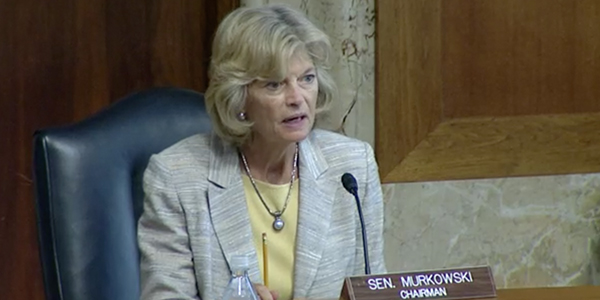The Senate Energy and Natural Resources Committee on Tuesday called attention to federal efforts to encourage emerging technologies aimed at carbon dioxide management, including removal, utilization and storage.
Chairwoman Lisa Murkowski (R-Alaska) said carbon management is a subject that should “captivate us all.” In less than a decade, she said, the idea of carbon dioxide removal has moved from focusing on planting trees to realistic approaches of technologies to permanently remove it from the air and the ocean that are needed and “worth pursuing.”
“Carbon management will very likely prove to be an important option for reducing emissions and the impacts of climate change,” Murkowski said.
To help scale up efforts of carbon removal research and development across different federal agencies, Murkowski announced she will introduce a bill with Sen. Kyrsten Sinema (D-Ariz.), the CREATE Act, which would establish an executive committee at the White House’s Office of Science and Technology Policy to coordinate interagency efforts on carbon removal research and development.
Ranking Member Joe Manchin (D-W.Va.) said technology that captures carbon from both power plants and out of the ambient air could be deployed anywhere in the world once it has “matured,” providing both economic and environmental benefits to the U.S. He touted his own bill introduced last year, the EFFECT Act, which would advance carbon removal technologies through federal funding of research projects.
Manchin said simply capturing carbon is not enough in the process and that technology needs to include additional applications. He said scientists at the National Energy Technology Laboratory are working on novel ways of using carbon, including decontamination of personal protective equipment and other medical equipment.
“We are seeing more and more opportunities for carbon dioxide use from commercial, industrial and defense purposes,” Manchin said. “This is where innovation can help the economies of fossil fuel-rich states like West Virginia while also helping to address our climate challenge.”
Steven Winberg, assistant secretary for fossil energy at the Energy Department, told the committee that work is ongoing to enhance large-scale carbon management. He said the department has provided about $85 million this year for five projects through the Carbon Storage Assurance Facility Enterprise (CarbonSAFE) Initiative to develop geological storage sites that can hold a minimum of 50 million metric tons of CO2 from industrial sources. The department is also getting ready to announce plans for up to $46 million for engineering-scale testing of next generation carbon capture technologies for coal and gas generation plants, he said.
The Coal FIRST (Flexible, Innovative, Resilient, Small, Transformative) initiative is developing coal power plant designs with carbon-neutral and net-negative emissions when coal and biomass are combined with carbon capture, utilization and storage programs, Winberg said, adding another layer of technological advances.
“These plants will have the flexibility that allows them to support our evolving electricity grid, and some will be able to produce hydrogen, which can play a significant role for electricity production, manufacturing and transportation,” Winberg said.
Julio Friedmann, a senior research scholar at the Center on Global Energy Policy at Columbia University, told senators that innovation remains the “nation’s strong suit” and called for continued financial support by the federal government in carbon management. He said “dramatic increases” in funding for both carbon capture and storage (CCS) and carbon removal follows recommendations contained in a 2019 Energy Futures Initiative report, which laid out specific line items and budgets for U.S. agencies.
Friedmann said one of the next steps needed for industries like power generation to adopt carbon management practices more widely is more effective tax incentives. He said recent analysis found that for utility-owned gas-fired power plants to deploy CCS, they would require $80/ton in incentives and closer to $110/ton for merchant power plants, which is in line with existing renewable tax credit provisions.
The greater the incentives, Friedmann said, the more carbon capture systems will be deployed and the more tons reduced or removed.
“This is the climate counterstrike, and I ask the committee to think about CO2 removal as the biggest market of all time,” Friedmann said.






